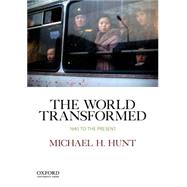Oxford University Press is pleased to be the new publisher of Michael Hunt's The World Transformed: 1945 to the Present. A second edition of The World Transformed will be available in Spring 2015.
Through its lively and accessible narrative, The World Transformed provides students with an account of the political, socio-economic and cultural developments that have shaped global events since 1945. The book's focus on three central and profoundly interconnected stories--the unfolding of the Cold War, the growth of the international economy, and the developing world's quest for political and economic independence--offers students a framework for understanding the past and making sense of the present. Attentive to overarching themes, individual historical figures, and diverse nations, The World Transformed will find an enthusiastic reception in courses on post-1945 world history, international relations, or global topics.








